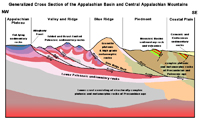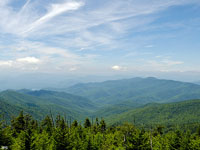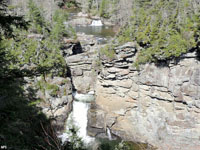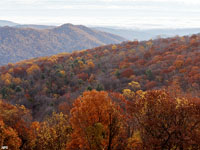
Regional Geology of North America |
Blue Ridge Province |
Click on images for a |
The Blue Ridge Mountains get their name from the typically bluish haze produced by natural aerosol compounds, isoprenes, that are released by trees in the southern Appalachian region—also the “smoky” applied to the Smoky Mountains. The Blue Ridge Mountains are a narrow band of a high mountainous ridges or a single high ridge that extend from southern Georgia northward into Pennsylvania. In geologic terms, the Blue Ridge forms the distinct eastern margin of the Southern Appalachian Mountains (Figure 28). For most of its length, the Blue Ridge rises high above the Piedmont lowlands to the east and the Great Appalachian Valley to its west (part of the Valley and Ridge Province). The highest mountain in the eastern United States, Mt. Mitchell (elevation 6,684 feet) is located in the southern Blue Ridge Mountains of North Carolina. More than 120 peaks in the Blue Ridge Mountains rise above 5,000 feet. For most of its length, the Blue Ridge Mountains are parklands including the Great Smoky Mountains and Shenandoah National Parks, connected by the scenic Blue Ridge Parkway and the Appalachian Trail for most of its length (Figures 29 to 32). Ancient metamorphic rocks exposed in the Blue Ridge formed from deep crustal compressional forces associated with the landmass collisions associated with the Grenville Orogeny, a regional metamorphism event associated with mountain building in Late Precambrian time, a little more than a billion years ago). These rocks exposed along the Blue Ridge consists of complex folded metamorphic rocks, mostly granitic gneiss (derived from more ancient volcanic and sedimentary rocks). The Blue Ridge began to rise in Silurian time (about 400 million years) and an erosional remnant of a much greater mountain range that formed in the middle to late Paleozoic Era as the North American continental landmass collided with Europe, Africa, and other smaller landmasses that assembled together to form the supercontinent Pangaea. At the peak of the Appalachian Orogeny (or Allegheny Orogeny) in Pennsylvanian to early Permian time (about 325 to 260 million years), the mountains would have rivaled the modern Alps is size and extent. Across North America. Sediments shed from the mountains flooded westward accumulating in the Appalachian Plateau region and regions further west (discussed below). |
 Fig. 28. Generalized cross section of the southern Appalachian Mountains region. |
| National Parks located in the Blue Ridge Mountains include: Shenandoah National Park (Virginia) Blue Ridge Parkway (North Carolina and Virginia) Great Smoky Mountains National Park (North Carolina, Georgia, and Tennessee) |
|
| https://gotbooks.miracosta.edu/geology/regions/a.html 1/20/2017 |



